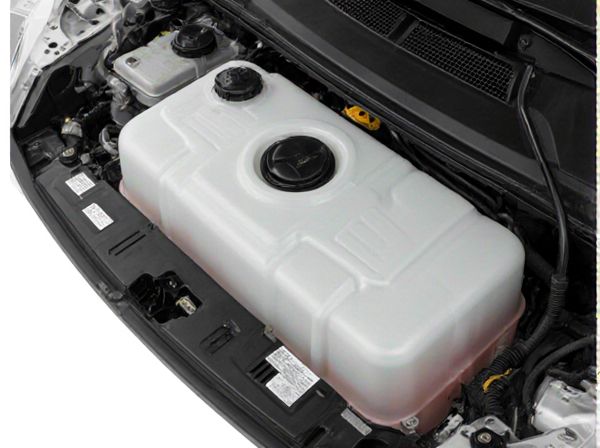
Photo illustration: Gravity Feed Tank vs Pump Feed Tank
Gravity feed tanks rely on elevation differences to move liquids, ensuring a simple, energy-efficient flow without mechanical parts. Pump feed tanks use mechanical pumps to transfer fluids, providing precise control over flow rate and pressure. Your choice depends on system requirements, with gravity feed being ideal for low-maintenance setups and pump feed suited for applications needing consistent, high-pressure delivery.
Table of Comparison
| Feature | Gravity Feed Tank | Pump Feed Tank |
|---|---|---|
| Fuel Delivery Method | Fuel flows by gravity, no mechanical assistance | Fuel delivered via electric or mechanical pump |
| Installation Complexity | Simple, fewer components | Complex, requires pump and wiring |
| Reliability | Highly reliable, fewer failure points | Dependent on pump operation; potential pump failure |
| Cost | Lower initial and maintenance cost | Higher cost due to pump and maintenance |
| Fuel Accessibility | Limited to gravity positioning; tank must be above engine | Flexible tank placement; pump overcomes elevation |
| Suitable Applications | Simple engines, older vehicle models | Modern engines, complex fuel systems |
Overview of Gravity Feed and Pump Feed Tanks
Gravity feed tanks rely on elevation to create pressure that moves fluid naturally without mechanical assistance, making them energy-efficient and simple for applications like water storage and distribution. Pump feed tanks use mechanical pumps to deliver fluids under pressure, enabling precise control of flow rate and pressure, which is essential for high-demand or complex systems. Both types serve different operational needs based on system design, elevation constraints, and required fluid dynamics.
How Gravity Feed Tanks Work
Gravity Feed Tanks operate by utilizing the natural force of gravity to move liquid from the tank to the desired location without mechanical assistance. The tank is positioned at an elevated height so that the fluid flows downward through pipes or channels, providing a consistent and energy-efficient supply. This system relies on hydrostatic pressure generated by the height difference between the tank and the outlet point, making it ideal for applications with low flow rate requirements or where power sources are limited.
How Pump Feed Tanks Operate
Pump Feed Tanks operate by using an integrated pump system to actively transfer liquids, ensuring consistent flow and pressure regardless of tank level or elevation. These tanks are equipped with electric or hydraulic pumps that draw fluid from the tank and deliver it at a controlled and adjustable rate, making them ideal for applications requiring precise fluid management. Unlike gravity feed tanks that rely on natural gravitational force, pump feed tanks provide enhanced efficiency and reliability in fluid distribution within industrial, agricultural, or fire protection systems.
Key Differences Between Gravity and Pump Feed Systems
Gravity feed tanks rely on elevation to create fluid pressure, making them energy-efficient and simple, while pump feed tanks use mechanical pumps to actively move liquid, allowing higher pressure and flow control. Gravity systems excel in low-maintenance applications with stable, moderate flow rates, whereas pump feed systems are versatile for varying demands and higher volume requirements. Maintenance complexity and installation costs are generally lower in gravity feed tanks but higher in pump feed tanks due to additional components.
Advantages of Gravity Feed Tanks
Gravity feed tanks offer the significant advantage of energy efficiency by utilizing natural gravitational force to dispense liquids, eliminating the need for electrical power or mechanical pumps. These tanks provide consistent and reliable fluid flow, reducing maintenance costs and minimizing mechanical failures common in pump systems. Their simple design ensures easier installation and operation, making them ideal for remote or off-grid locations where power sources are limited.
Benefits of Pump Feed Tanks
Pump feed tanks offer precise control over fluid delivery, ensuring consistent pressure and flow rates vital for industrial processes. They enable reliable operation in systems with varying elevation or distance, eliminating limitations posed by gravity feed systems. Enhanced flexibility and automated flow regulation make pump feed tanks ideal for complex applications requiring accurate dosing or circulation.
Limitations of Gravity Feed Solutions
Gravity feed tanks rely on elevation differences to move liquids, which limits their effectiveness in applications requiring consistent and high-pressure flow. They are unsuitable for installations where space constraints prevent adequate height placement, leading to insufficient fluid delivery rates. Gravity systems also struggle with variable demand, as the flow rate diminishes as the liquid level drops, making them less reliable compared to pump feed tanks in dynamic environments.
Drawbacks of Pump Feed Systems
Pump feed tanks often face drawbacks such as increased mechanical complexity, which raises maintenance requirements and the risk of component failure. They consume more energy compared to gravity feed tanks, leading to higher operational costs and potential efficiency losses. Additionally, pump feed systems may introduce pulsation and pressure fluctuations, affecting the stability and consistency of fluid delivery.
Applications and Industry Use Cases
Gravity feed tanks are widely used in industries like oil and gas, agriculture, and water treatment where fluid delivery depends on height differences for passive flow, offering energy-efficient solutions for storage and dispensing of liquids. Pump feed tanks find applications in chemical manufacturing, pharmaceuticals, and food processing industries where precise control over fluid flow rate and pressure is crucial for mixing, dosing, and transfer operations. Both systems are essential in sectors requiring reliable liquid handling, with gravity feed tanks suited for low-pressure applications and pump feed tanks preferred in environments demanding consistent, pressurized fluid delivery.
Choosing the Right Feed Tank System for Your Needs
Choosing the right feed tank system depends on factors such as site elevation, flow rate, and maintenance capabilities. Gravity feed tanks offer simple, energy-free operation ideal for small-scale or remote applications, while pump feed tanks provide precise flow control and are better suited for industrial setups requiring consistent pressure. Evaluating system complexity, cost, and process requirements ensures optimal selection between gravity and pump feed tanks for efficient fluid delivery.
 caratoz.com
caratoz.com